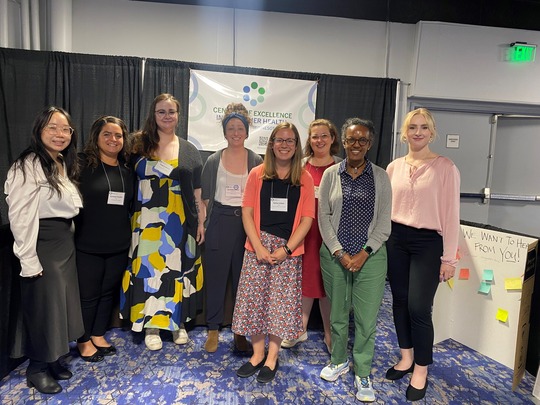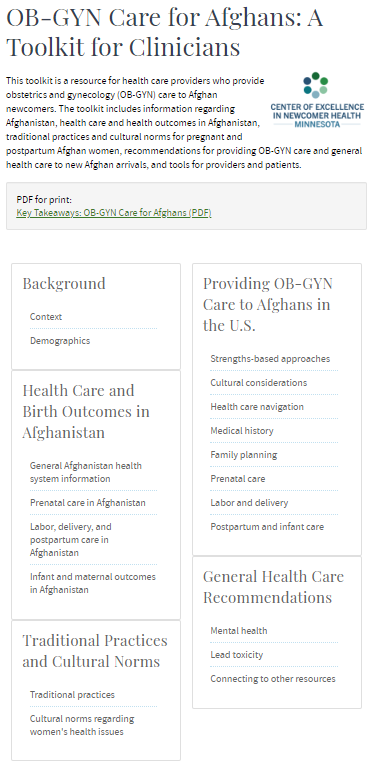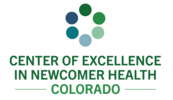Center of Excellence in Newcomer Health
|
|
|
View this as a webpage
October 2024

1. What is a virtual R&P?
A. An interactive artificial intelligence program available to all newcomers to help them review and process their plan of arrival.
B. A virtual medical appointment with a health care provider to complete the domestic medical screening.
C. A virtual reception and placement for qualifying refugees and SIVs, primarily Afghans and Central and South Americans.
For our clinical audience…
2. A newcomer patient presents with an uncertain date of birth. Their parent states that they are not sure of their date of birth but thinks the year might be 2012. You notice that their legal documentation shows a date of birth of Jan. 1, 2012. As you complete your medical care and psychosocial screening for wellbeing, you notice that the biological age of the patient may not be in alignment with what their legal documents indicate.
What are your next steps (select all that apply)?
A. Discuss with parent the season and events that happened around the time of the patient’s birth to help determine a more accurate approximate date of birth.
B. Order radiographic bone and dental scans to estimate age.
C. Consult with a developmental-behavioral pediatrician and/or child psychologist who specializes in appropriate developmental milestone attainment and psychosocial development assessments.
D. Carry out care in accordance with legal age.
E. Communicate with the child’s school.
Answers at the end of the newsletter
|
Clarification on our July pop quiz:
We had a couple of people reach out with questions about Hepislav, the two-dose hepatitis B vaccine. This is generally not available overseas, so unless a vaccine record explicitly says they received Hepislav, it should be assumed they received a three-dose vaccine. Read more about hepatitis B vaccines at CDC: Immunizations Refugee Health Domestic Guidance.
This year’s North American Refugee Health Conference (NARHC), held in Minneapolis on Aug. 5-7, 2024, was the largest yet, with over 1,000 attendees. It was wonderful to see many of our local public health and clinician colleagues in person. The Minnesota Center of Excellence in Newcomer Health, MDH Refugee Health team, Colorado Center of Excellence in Newcomer Health, and refugee health practitioners from across the world gave many successful presentations and workshops, advancing the field of refugee and immigrant health.
Thank you to everyone who connected with us, stopped by the booth, came to our presentations, and came by and said hi! We look forward to seeing everyone at the Refugee Health Conference in Halifax next year!

CDC’s National Healthcare Safety Network (NHSN) and Social Determinants of Health has developed an abridged language list with over 500 languages, ready to integrate into electronic health records (EHR). This list was initially developed by the Minnesota COE and supplemented and cross-referenced by several other organizations, including Languages of New York City, Ethnologue, and Glottolog. Of note, the NHSN Abridged Primary Language List is not meant to be exhaustive, exclusionary, or imply the importance of any groups of language speakers over others. The list provides common languages spoken in U.S. subpopulations and only includes languages spoken where English fluency cannot be presumed.
This will be available for implementation into EHRs starting in January 2025. In January 2026, these vendors will be required to adopt this language list, in a fashion that supports hierarchical multi-select options and include requirement for documentation of interpretation need.
What does this mean for U.S. health care providers?
Equitable language access in EHRs facilitates care and interpreter services for patients who speak languages other than English. This will hopefully result in reducing barriers and difficulties in seeking medical advice, making medical appointments, understanding medical diagnoses, treatment plans, consent to treatment, follow-up care, and accessing pharmacy services. Health care providers can work with their EHR vendors to integrate this language list into their EHR in January. Read more about the importance of language equity and how this list was developed, in addition to accessing the NSHN Abridged Primary Language List, at CDC: Immunizations Refugee Health Domestic Guidance.
|
|

We received your feedback after our Afghan Arrivals: Pre- and post-natal care webinar and created a toolkit!
The OB-GYN Care for Afghans: A Toolkit for Clinicians is both informational and action oriented, to empower health care providers to give culturally informed reproductive health care to newly arrived Afghans.
Each section is equipped with a combination of supplemental trainings and resources for providers and translated educational handouts in Dari and Pashto.
|
Strongyloidiasis microlearning

We have added a new resource to our training portfolio, Microlearnings! This series will be comprised of three- to five-minute-long videos that give a high-level overview of both emerging issues and screening guidance for the Domestic Medical Exam. Our first installation is live on our website and focuses on Strongyloidiasis: Trainings: Microlearning series.
|
Missed a webinar? Don’t sweat it!
The following recordings have recently been finalized for accessibility and are posted on our website:
Visit Trainings: Minnesota Center of Excellence in Newcomer Health for more information.
ECHO Colorado Newcomer Health Series
In partnership with ECHO Colorado, the Minnesota Center of Excellence in Newcomer Health has been hosting a monthly training on newcomer health since Oct. 25, 2022.
Register for the 2024 series on the ECHO Colorado Website! Please note that ECHO has a new website, so you may need to clear your internet history/cache before registering.
Access recorded sessions and resources: Newcomer Health ECHO Resource Page
Immunizations from people from Central/South America
Immunizations are offered and administered as part of the overseas medical exams that are completed by the International Office of Migration Panel Physicians. The immunizations that are given are subject to the cost and availability in the local market. Refugees may receive vaccines through the Ministry of Health in their country of residence; however, they may also face limitations in supply due to cost and availability. As such, refugees from Central and South America may not have received as many vaccines as other regions.
What does this mean for U.S. health care providers?
For providers receiving newcomers from Central and South America, please make sure you are doing a thorough review of their immunizations and provide education about which immunizations you can offer during that appointment. Read more at CDC: Immunizations Refugee Health Domestic Guidance.
Hepatitis C in the incoming Rohingya community
Both the Lancet and the WHO have recently reported that between 20 and 37% of Rohingya adults in refugee camps in Cox’s Bazar have tested positive for hepatitis C virus (HCV), and nearly 74% had active hepatitis C infection and needed treatment.
The WHO reported that 83% of the people who they screened were women, which draws concerns for vertical transmission to their children. This is pursuant with the 2017 and 2023 MMWR articles, which called for enhanced identification through testing all pregnant women with HCV risk factors and improved public health surveillance of infants at risk for HCV vertical transmission.
This will improve identification, detection, and care for both HCV-infected women and infants at risk for vertical transmission.
What does this mean for U.S. health care providers?
For providers receiving newcomers from Rohingya, it is prudent to screen all individuals for HCV.
Read more about hepatitis C screening at CDC: Viral Hepatitis Refugee Health Domestic Guidance.
Revisions to the Refugee Health Domestic Guidance on Tuberculosis
On July 30, 2024, the CDC: Tuberculosis Refugee Health Domestic Guidance was updated. Many of these changes were to ensure it aligns with the recently updated CDC: Tuberculosis Technical Instructions for Panel Physicians.
The key changes include:
- Age-based TB testing recommendations for refugees < 2 years and ≥ 2 years of age.
- TB testing considerations for refugees assigned Class B3 TB (known contact to a person with infectious TB disease).
- TB testing considerations for refugees at continued risk of exposure to TB after the overseas examination while still overseas or after arrival in the United States.
Mpox
On Aug. 13 and 14, both the Africa CDC and WHO declared an mpox outbreak in the Democratic Republic of Congo.
Additionally, on Sept. 23, CDC also issued a Health Alert Network (HAN) health update that outlines Prevention Strategies for Mpox, including Vaccinating People at Risk via Sexual Exposure, for U.S. Travelers Visiting Countries with Clade I Mpox Outbreaks.
Increased Oropouche virus activity and associated risk to travelers
A CDC HAN Health Advisory was issued on Aug. 16 to notify clinicians and public health authorities of an increase in Oropouche virus disease in the Americas region, originating from endemic areas in the Amazon basin and new areas in South America and the Caribbean.
For more information and clinical/public health guidance:
Marburg virus disease (Marburg) in Rwanda
On Oct. 3, 2024, CDC issued a HAN Health Advisory: First Marburg Virus Disease Outbreak in the Republic of Rwanda. Rwanda had 36 individuals with confirmed Marburg virus disease. According to the Republic of Rwanda Ministry of Health, 11 of those individuals have died. Nineteen of the cases were in health care workers.
CDC's Division of Global Migration Health (DGMH) is working closely with partners, including the International Organization for Migration (IOM) and Bureau of Population, Refugees, and Migration (PRM) to monitor this situation. Although no cases have been identified in refugees in Rwanda to date, departures of refugees from Rwanda are on hold until more information is available. At present, considerations are being made for a 21-day pre-departure surveillance period for people from Rwanda.
Take a moment and review some recent publications on newcomer health:
- de Acosta D, Moore T, Alam F, Hoffman SJ, Keaveney M, Mann E, Dawson-Hahn E. "It spreads like wildfire": mothers' gatherings for vaccine acceptance. Front Public Health. 2024 Aug 27;12:1198108. doi: 10.3389/fpubh.2024.1198108. PMID: 39257942; PMCID: PMC11383782.
- Nakkash R, Ghandour L, Brown G, Panter-Brick C, Bomar H, Tleis M, Al Masri H, Fares M, Al Halabi F, Najjar Y, Louis B, Hodroj M, Chamoun Y, Zarzour M, Afifi RA. Syrian refugee young adults as community mental health workers implementing problem management plus: Protocol for a pilot randomized controlled trial to measure the mechanisms of effect on their own wellbeing, stress and coping. Contemp Clin Trials Commun. 2024 Jun 28;40:101325. doi: 10.1016/j.conctc.2024.101325. PMID: 39045391; PMCID: PMC11263753.
- Muller, R., Bilich, L. & Jones, M. Impact of an Oral Health Education Program on the Oral Health Literacy of Refugees. J Immigrant Minority Health 26, 699–710 (2024). https://doi.org/10.1007/s10903-024-01594-6
- Terrana A, Bruno W, Ibrahim N, Kaiser BN, Wei J, Al-Delaimy W. The Somali Distress and Resilience Scale: Development of a novel measure for Somali adults. Transcult Psychiatry. 2024 Aug 31:13634615241272982. doi: 10.1177/13634615241272982. Epub ahead of print. PMID: 39215519.
- Ding A, Osorio M, Teferi M, Gallo Marin B, Cruz-Sánchez M, Lorenz M, Michelow IC. A Retrospective Longitudinal Study of Refugees With Eosinophilia at an Academic Center in the United States From 2015 to 2020. Open Forum Infect Dis. 2024 Jul 19;11(8):ofae430. doi: 10.1093/ofid/ofae430. PMID: 39155943; PMCID: PMC11327920.
- Kaki DA, Bridi L, Mwendwa P, Aso M, Behnam R, Bencheikh N, Albahsahli B, Khan X, Aljenabi R, Sideman AB, Moore A, Al-Rousan T. Attitudes Towards Dementia Among a Diverse Group of Refugees Resettled in the United States. J Geriatr Psychiatry Neurol. 2024 Sep 3:8919887241280891. doi: 10.1177/08919887241280891. Epub ahead of print. PMID: 39224935.
|
|

Did you know that we are one of two centers established by support from the Centers for Disease Control and Prevention? Visit our partner site: Colorado COE in Newcomer Health!
The Colorado team leads data/epidemiology and public health navigation initiatives through partnerships with states and sites across the country. Their primary goal is to maintain a data repository to identify and respond to the changing landscape of newcomer health, with a focus on domestic medical exams and long-term health follow-up data.
Additionally, they support public health teams in ensuring that all populations are included in public health responses, regardless of culture or language. They develop best practices, toolkit resources, and capacity-building trainings for navigators and public health teams.
|
Please sign up now if you are not already subscribed to Minnesota Center of Excellence in Newcomer Health Updates and wish to receive future editions.
For more information or questions, please contact the Minnesota Department of Health Refugee Health Program at refugeehealth@state.mn.us or 651-201-5414.
The Minnesota Center of Excellence in Newcomer Health is supported by NU50CK000563 (MN) from the U.S. Centers for Disease Control and Prevention.
|
|
|
|